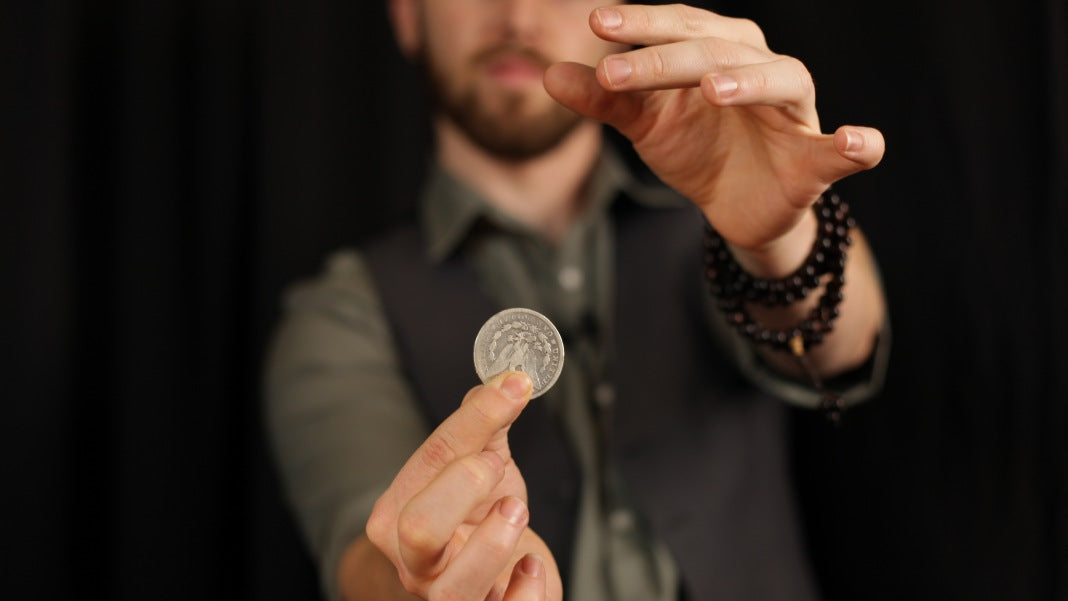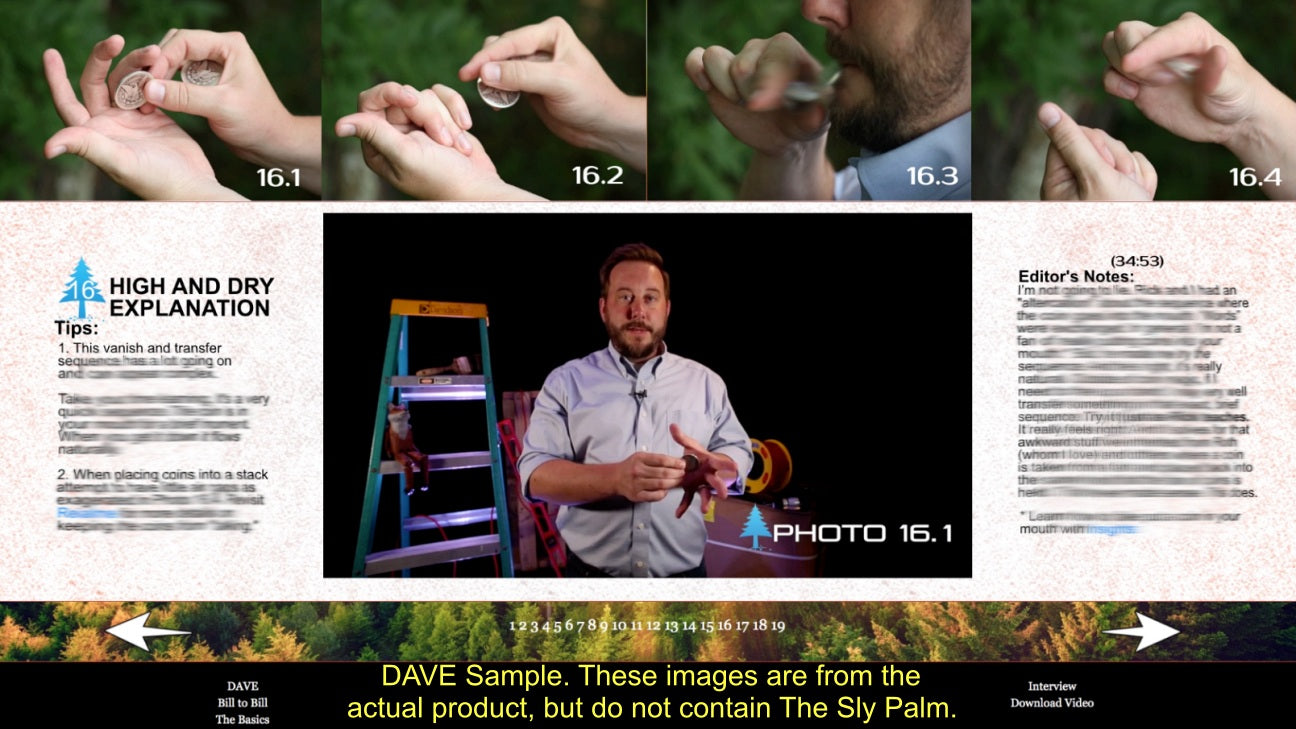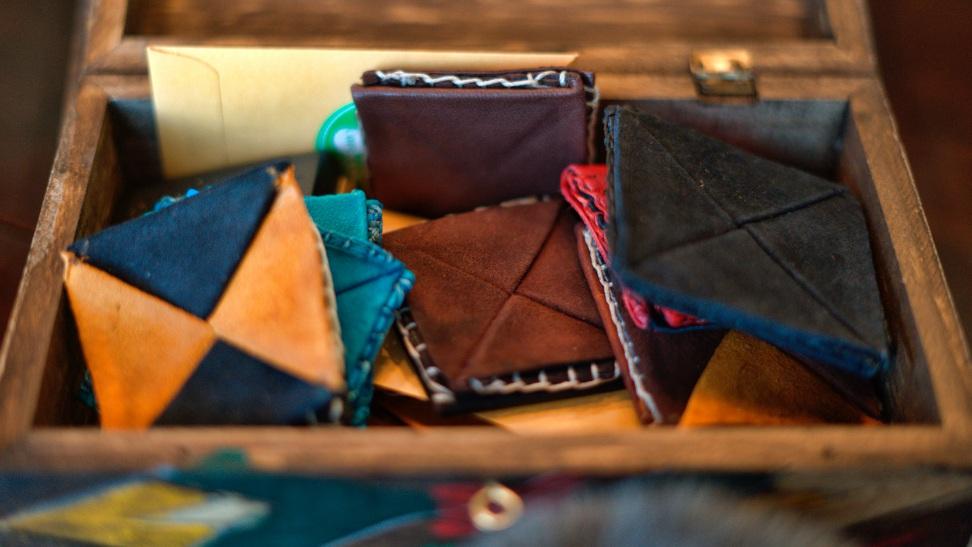Telegraphing

~ Guest Post by Danny Goldsmith ~
We all want to get great reactions from our spectators with our coin magic. Too often we may get the spectator with their arms crossed, scowl on their face, speculating about how it may have been done. We want the magic to look impossible! I personally prefer the spectator is laughing hysterically, dancing around, or standing there stunned with jaw dropped and eyes wide open. When I’m lucky, I get mind-shattering tears of joy—a spectator reintroduced to their child-like wonder.
There are many ways to properly perform magic to get these kinds of reactions. Today, I want to talk about the element of surprise: how to lead your spectator so that they are not anticipating each climax.
There are many ways we ruin the surprise by telegraphing what we are about to do. I believe the biggest way is with our patter. It’s our language that most often gives us away.
For example, I have often seen coin magicians produce a coin and say, “That’s the first.” The problem with this is that you have now told the spectator that a second coin is coming. They are now looking for where the second coin is being concealed when they might have subconsciously felt the hand was empty had you simply produced a coin and said “A silver dollar. This one is from 1887; Einstein may have touched this coin.”
With the latter example the spectator has now directed their attention to the coin and the description of the coin rather than speculate about what will happen next. Because the spectator has not started to anticipate the next move, the subconscious assumption is that there is only one coin. Within this assumption a Ramsey subtlety or any other means of showing the hands partially empty is more likely to convince the spectator of an empty hand, due to their lack of analysis and speculation. This allows for the second coin to be a surprise as well as to give the illusion that the hands were empty before the production.
So, with good patter we bring the spectator’s attention to a detail about the present moment and relieve their impulse to anticipate the next move. With bad patter, our language gives away our next move and spoils our presentation.
There are exceptions: Giving yourself away can sometimes make an effect look more impossible. If you were to tell your spectator that you were about to produce a coin and then showed your hands unmistakably empty, fingers spread and from here produced a coin…well, then you have a miracle.
I hope this helps you to look at how your presentation is subconsciously communicating to your spectators. These little details help us establish magic in their minds rather than simply fool their eyes. Magic that happens in our minds has the power to invoke child-like wonder and therefore bring great joy to our spectators. It is an experience they will never forget.
For mind numbing coin magic, follow Danny Goldsmith on Instagram @dannygoldsmithmagic.











I was recently scammed out of $53,000 by a fraudulent Bitcoin investment scheme, which added significant stress to my already difficult health issues, as I was also facing cancer surgery expenses. Desperate to recover my funds, I spent hours researching and consulting other victims, which led me to discover the excellent reputation of Capital Crypto Recover, I came across a Google post It was only after spending many hours researching and asking other victims for advice that I discovered Capital Crypto Recovery’s stellar reputation. I decided to contact them because of their successful recovery record and encouraging client testimonials. I had no idea that this would be the pivotal moment in my fight against cryptocurrency theft. Thanks to their expert team, I was able to recover my lost cryptocurrency back. The process was intricate, but Capital Crypto Recovery’s commitment to utilizing the latest technology ensured a successful outcome. I highly recommend their services to anyone who has fallen victim to cryptocurrency fraud. For assistance contact Recoverycapital@fastservice.com and on Telegram OR Call Number +1 (336)390-6684 via email: Capitalcryptorecover@zohomail.com you can visit his website: https://recovercapital.wixsite.com/capital-crypto-rec-1
PROFESSIONAL CRYPTO RECOVERY EXPERT→THE HACK ANGELS
I want to use this Medium to say big thanks to THE HACK ANGELS RECOVERY EXPERT for helping me recover my stolen crypto worth $960,000 through their hacking skills. I tried it. I was skeptical but it worked and I got my money back. I lost access to my digital wallet and lost all my crypto assets. I was devastated and felt like the world was pulling down on me. I had no idea of how to get back access to my crypto assets and gave up trying to get it back. I was scrolling through the internet and saw a post about a Crypto recovery company that goes by the name THE HACK ANGELS RECOVERY EXPERT. I didn’t hesitate to contact them and provided them with all the information. Throughout the process, communication was essential, and frequent updates gave much-needed transparency and assurance. They have a track record of successful cryptocurrency recovery, the firm has assisted several clients in recovering their lost or stolen digital assets. I highly recommend their services if you ever need a professional and reliable crypto recovery team.
You can contact them through their hotline at (support@thehackangels.com) They also have a great website at (www.thehackangels.com)
WhatsApp +1(520)200-2320)
I promised to give back a review on their wonderful job well done
PROFESSIONAL CRYPTO RECOVERY EXPERT→THE HACK ANGELS
I want to use this Medium to say big thanks to THE HACK ANGELS RECOVERY EXPERT for helping me recover my stolen crypto worth $960,000 through their hacking skills. I tried it. I was skeptical but it worked and I got my money back. I lost access to my digital wallet and lost all my crypto assets. I was devastated and felt like the world was pulling down on me. I had no idea of how to get back access to my crypto assets and gave up trying to get it back. I was scrolling through the internet and saw a post about a Crypto recovery company that goes by the name THE HACK ANGELS RECOVERY EXPERT. I didn’t hesitate to contact them and provided them with all the information. Throughout the process, communication was essential, and frequent updates gave much-needed transparency and assurance. They have a track record of successful cryptocurrency recovery, the firm has assisted several clients in recovering their lost or stolen digital assets. I highly recommend their services if you ever need a professional and reliable crypto recovery team.
You can contact them through their hotline at (support@thehackangels.com) They also have a great website at (www.thehackangels.com)
WhatsApp +1(520)200-2320)
I promised to give back a review on their wonderful job well done
FRESH FULLZ USA UK CANADA GERMNAY ITALY SPAIN
REAL DL SCAN FRONT BACK WITH SELFIE
What’s App = +1.. 727.. 788… 6129…
Tele Gr@m = @ killhacks OR @ leadsupplier
Skype = @ peeterhacks
E mail = hacksp007 at g mail dot com
SSN DOB DL ADDRESS PHONE EMAIL FULLZ
NIN DOB ADDRESS SORT CODE & ACCOUNT NUBER FULLZ
SIN DOB ADDRESS MMN PHONE EMAIL
DL FRONT BACK WITH SELFIE & SSN
CANADA UK RU FR IT DE DL FRONT BACK
BUSINESS EIN COMPANY FULLZ
YOUNG & OLD AGE FULLZ
HIGH CREDIT SCORES FULLZ PROS
FULLZ WITH MVR
TAX RETURN FILLING & KYC STUFF FULLZ
PAYDAY LEADS & LOAN LEADS
SWEEPSTAKES & COMBOS
BULK FULLZ AVAILABLE
PASSPORT PHOTOS WITH SELFIE
W-2 FORM WITH DL FRONT BACK
#usafullz #ssndobdl #ukfullz #ninfullz #canadafullz #sinfullz
#cccvvshop #dumpscvv #fullzusauk #fullzdlssn #einfullz
#sellssnfullz #w2formusa #highcspros
Many other stuff available fresh sp@mmed
Guaranteed & verified fullz
Replacement will also be provided for invalid or bad fullz
Available all day 24/7
I was recently scammed out of $53,000 by a fraudulent Bitcoin investment scheme, which added significant stress to my already difficult health issues, as I was also facing cancer surgery expenses. Desperate to recover my funds, I spent hours researching and consulting other victims, which led me to discover the excellent reputation of Capital Crypto Recover, I came across a Google post It was only after spending many hours researching and asking other victims for advice that I discovered Capital Crypto Recovery’s stellar reputation. I decided to contact them because of their successful recovery record and encouraging client testimonials. I had no idea that this would be the pivotal moment in my fight against cryptocurrency theft. Thanks to their expert team, I was able to recover my lost cryptocurrency back. The process was intricate, but Capital Crypto Recovery’s commitment to utilizing the latest technology ensured a successful outcome. I highly recommend their services to anyone who has fallen victim to cryptocurrency fraud. For assistance, contact Recovercapital@cyberservices.com Capital Crypto Recover on Telegram OR Call Number +1 (336)390-6684 via email: Capitalcryptorecover@zohomail.com
Leave a comment